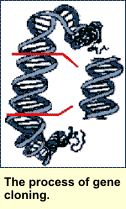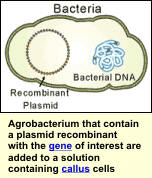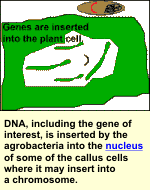
Transformation is the step in the genetic engineering
process where a new gene (transgene) is delivered
into the nucleus of a plant cell and inserts into
a chromosome where it is passed on to progeny. Transformation
means to genetically change a living thing. A genetically
engineered plant has been transformed and is sometimes
referred to as a transgenic plant.
Transformation is typically done on callus cells
(tissue culture) but is occasionally done to other
plant parts, such as germline cells or pollen. Tissue
culture is clusters of undifferentiated plant cells
called 'callus', which are grown in culture. This
allows them to be manipulated and then induced to
develop into whole plants containing a copy of the
transgene in every cell.
There are many methods used to deliver extra DNA
into the nucleus of plant cells.
|
Gene Gun
 This method works by shooting DNA into the
plant cells. Microscopic gold or tungsten particles
are coated with hundreds of copies of the gene(s)
to be introduced. Tissue culture cells are placed
in a vacuum chamber and the metal particles
are propelled with a high-pressure gas that
is released in a sudden burst much like a popped
balloon or air gun. This method works by shooting DNA into the
plant cells. Microscopic gold or tungsten particles
are coated with hundreds of copies of the gene(s)
to be introduced. Tissue culture cells are placed
in a vacuum chamber and the metal particles
are propelled with a high-pressure gas that
is released in a sudden burst much like a popped
balloon or air gun.

|
|
Agrobacteria
 Agrobacteria is a soil bacteria
that works as a natural genetic engineer. In nature
it forces plants to become good hosts by inserting
genes into plant cells that cause the plant to
make metabolites they need for growth. Genetic
engineers have taken advantage of Agrobacteria's
natural abilities by tricking them to insert an
altered piece of DNA that contains the desired
transgene into cells.
Agrobacteria is a soil bacteria
that works as a natural genetic engineer. In nature
it forces plants to become good hosts by inserting
genes into plant cells that cause the plant to
make metabolites they need for growth. Genetic
engineers have taken advantage of Agrobacteria's
natural abilities by tricking them to insert an
altered piece of DNA that contains the desired
transgene into cells.
|
|
Microfibers - 'Whiskers'
The Whiskers method uses
microscopic "wiskers" that look like tiny needles
with sharp ends.
Tissue culture
cells, hundreds of copies of the desired gene(s), and whiskers are suspended in a tube
of solution and shaken vigorously. The tiny
whiskers stab the plant cells potentially delivering
the desired gene into the nucleus of the cell without
killing it. For expanded information on Whiskers technology click here.
Electroporation
Electroporation uses a quick pulse of electricity to open tiny pores in the walls of plant cells. If DNA is mixed in a solution with the cells, the DNA molecules are small enough to pass into the cell through these holes.
The goal of any transformation technique is to transport the new gene into the nucleus of a cell without destroying it. After that, the genetic engineer has no control as to how or even if the gene will insert into a chromosome. The successful genetic engineer plays the numbers game. Because they cannot control all of the steps, they repeat the process hundreds of times in order to produce one genetically engineered plant.
|
Selectable Marker Genes
Genetic engineers must be able to select cells that have received the transgene from those that have not. Selecting out transgenic cells is done by co-transforming the cells with the transgene plus an additional gene called a selectable marker gene. Selectable marker genes are genes that encode easily detectable traits making transgenic cells easy to select out from non-transgenic cells. The two most commonly used selectable marker genes encode the traits of herbicide and antibiotic resistance.
|
|
Events
Of the few cells that are
actually transformed during the transformation
process, very few will have all the characteristics
necessary to become a marketable event. An 'event'
is the insertion of a particular transgene into
a specific location on a chromosome. The term
"event" is often used to differentiate genetically
engineered crop varieties. Desirable events
are rare. Most events are discarded because
the transgene inserted into an existing gene
important for plant growth causing the existing
gene to be disrupted and not express, or the
transgene inserted into a portion of the chromosome
that does not allow for expression of the transgene
or expression that is too low.
Those events that are successful are grown
to mature plants. The seed is harvested and
passed on to a plant breeder who performs the
last step of the process.
|
|









